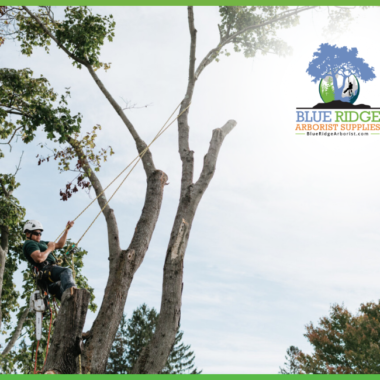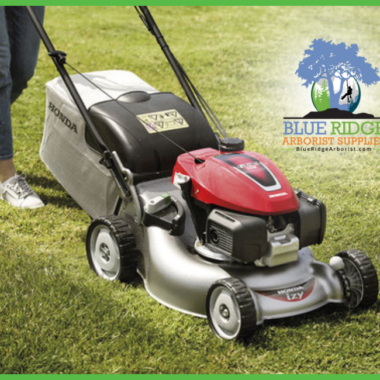There are several factors that an arborist should be aware of while climbing. You know how a small mistake or misstep can go unnoticed — and be the cause of an accident. We liked this review to help avoid these scenarios! Do inbox or email us with your best safety tips, anecdotes, and things you want to share! We are always interested in featuring your company, with your own stories and tips!
Brett Nelson, owner of Good Earth Tree Care in Grand Rapids, Michigan, suffered a serious fall from a tree and chose to share his experience with us. The available information suggests there might be unanticipated issues associated with his climbing system that other climbers in situations like Nelson’s should carefully consider.
This summary of what is known about the serious incident was written at Nelson’s request and with his input, in order to raise climber awareness.
On July 20, 2021, Nelson was working his way out on a large, horizontal limb on a honey locust, about 30 feet off the ground and overhanging a house roof. His goal was to load-lighten and reduce the end of the limb, as well as to remove some water sprouts. He was climbing SRS using a Rope Runner Pro mechanical Prusik with Teufelberger Xstatic 11.7 mm kernmantle climbing line.
Nelson had been using the mechanical Prusik since late November 2020, and it had taken him four or five climbs to get it adjusted well to his weight and rope selection.
On ascent, he typically attached the Rope Runner Pro via a small carabiner to a chest strap, but for maneuvering through the canopy and descending, he relied solely on the primary attachment to the front-suspension anchor point on his saddle.
As Nelson moved farther out on the limb with his back to the tree trunk, he felt increasingly uncomfortable with his stability, and he crouched and grabbed a small upright branch to steady himself. Unfortunately, the branch broke. Nelson knew he was falling off the limb and would likely take a big swing into the trunk, so he turned his head to look in his direction of travel.
What happened next is unclear, but instead of swinging he fell, almost unabated, to the ground, landing on his side. A crew member called 911, first responders arrived very quickly and Nelson was transported to the hospital, where he spent three days. He had several fractured ribs, a small puncture in one lung and a fractured spinous process on one vertebra. He is expected to make a full recovery.

Crew members pulled Nelson’s line and packaged all his gear. Closer inspection by Nelson several days after the incident revealed nothing wrong with the Rope Runner Pro or any other component of the climbing system, but clearly the device didn’t grab the line and arrest the fall as he expected. Possible contributing factors include:
- Slack in the system – Nelson believes his system had slack in it and the Rope Runner Pro wasn’t “loaded” the instant before the fall.
- The climber’s position – Nelson fell over backward and into the slack. His body would have been essentially horizontal rather than vertical.
- Deactivating the device – One instinctively tries to grab something as they fall. Nelson cannot be completely sure he didn’t grab the “bird” (upper part of the Rope Runner) as he started to fall, which would have prevented the device from loading and grabbing.
- The tail of the line above the device – Having reflected on the accident since first notifying TCIA about it, Nelson now believes there is a good chance that the tail of his climbing line was on the opposite side of the limb after he slipped off, so the tail would have been above him. Nelson has heard that other climbers have had the Rope Runner slip on them when the tail of their rope was above them.
Kevin Bingham, inventor of the Rope Runner, was contacted for his input. From reading the summary TCI provided, it sounded to him like an unintentional disengagement of the device in some way. Bingham related that recently there had been a serious accident involving the Rock Exotica Akimbo, when slack in the rope led to the Akimbo being hooked underneath the climber’s chain-saw keeper. That victim free fell 30 feet as well. It is possible the victim in this case could have had the Rope Runner Pro hooked under some part of his equipment or body. Bingham felt this was an inherent characteristic with mechanicals such as the Rope Runner, Akimbo and Rock Exotica Unicender.
Nelson told TCI that Vertical Supply Group, the manufacturer and distributor of the Notch Rope Runner and Rope Runner Pro, contacted him after the incident and offered to replace his Rope Runner Pro with a brand-new one so that the device involved in the incident could be fully inspected. On the advice of legal counsel, Nelson declined the offer.
TCI’s take-away is that the Rope Runner Pro, like other mechanicals, is not the perfect fit for all climbing styles straight out of the box. There is a learning curve involved to become highly proficient with it, and what we’ll call climbing “habits” that must be adopted to be successful with it.
The Rope Runner Pro User Instructions, a public-domain document that Notch freely makes available for the climbing community, contains 14 pages of pictograms and 4½ pages (English) of written instruction. All the possible scenarios discussed in this article that could have caused the system to fail – slack in the system, grabbing the bird, tail of the line above the device, interference with another component of the climber’s gear – are discussed and depicted in the User Instructions. TCI excerpted two illustrations from the User Instructions, which accompany this article, to make this point: If you plan to trust your health and well-being to a device or a system, be sure to read the instructions.
The best possible advice to a new user is to talk to, observe and ask questions of a proficient user as the new user adapts their climbing style and other in-the-tree practices to the new device. YouTube videos are great to a point, but they cannot replace training and coaching from a subject-matter expert. When learning any new technique or piece of equipment that will be used for work at height, practice “low and slow” at first.
Regardless of what climbing technique and system one uses, the use of multiple points of attachment to mitigate falls and swings is always a good idea. Using a long lanyard, using the tail of the rope as an extra system or using two separate systems entirely ensures redundancy, as well as more stable work positioning.
Through our print publication and website, TCI Magazine strives to be an objective third party, so that we may bring timely and unbiased information to the arborist community.
Update – There is a new potential contributing factor to consider.
Shortly after TCI went to press, Notch Equipment, manufacturer of the Rope Runner Pro, issued a recall notice for the device, citing, “… limited reports of users experiencing malfunctioning ‘birds’” while using the device. In case you are not familiar with the Rope Runner, the bird is the upper part of the device most responsible for grabbing the rope and holding the climber in a stationary position.
The notice cautioned users to do a manual inspection and function test of their device to make sure the bird recoils smoothly and without resistance.
The notice calls out devices with specific dates of manufacture as being particularly suspect. The victim’s device in this case was manufactured on one of the specified dates.
If you need to add to your safety gear for your arborist work, Blue Ridge Arborist Supplies has all of the tools and PPE you require. Call us today and let us help you with what you need! 540.485.4235 or find us on Facebook.
Reference: [https://tcimag.tcia.org/tree-care/consider-all-the-factors-in-a-climbers-fall/]










